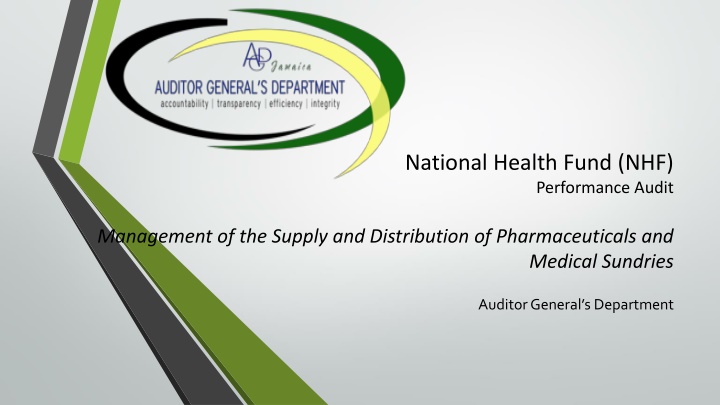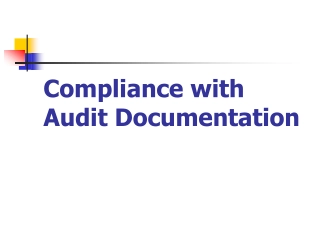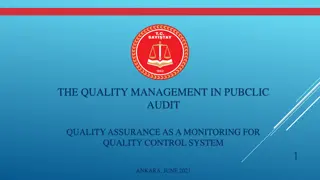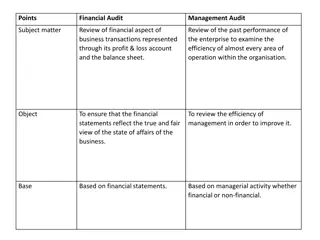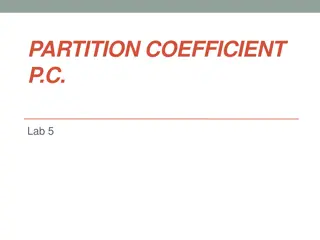NHF Performance Audit on Supply and Distribution of Pharmaceuticals
The National Health Fund underwent a performance audit to evaluate its management of pharmaceutical supplies and distribution efficiency. Findings revealed improvements in spoilage reduction and challenges in consistent supply of essential drugs impacting service levels for critical and chronic illnesses. The audit covered the period from FY2011/12 to FY2016/17, focusing on NHF's adherence to quality public health delivery aligned with Vision 2030 National Development Plan.
Download Presentation

Please find below an Image/Link to download the presentation.
The content on the website is provided AS IS for your information and personal use only. It may not be sold, licensed, or shared on other websites without obtaining consent from the author.If you encounter any issues during the download, it is possible that the publisher has removed the file from their server.
You are allowed to download the files provided on this website for personal or commercial use, subject to the condition that they are used lawfully. All files are the property of their respective owners.
The content on the website is provided AS IS for your information and personal use only. It may not be sold, licensed, or shared on other websites without obtaining consent from the author.
E N D
Presentation Transcript
National Health Fund (NHF) Performance Audit Management of the Supply and Distribution of Pharmaceuticals and Medical Sundries Auditor General s Department
Summary The National Health Fund Act was amended in 2011 to allow for a transfer of the assets and liabilities of the Health Corporation Limited (HCL) to the NHF, which assumed responsibility for the procurement, warehousing and distribution of pharmaceuticals and medical sundries. The performance audit covered the period FY2011/12 to FY2016/17. The audit sought to determine whether the NHF s Pharmaceutical Division efficiently and effectively managed its supplies and distribution of pharmaceuticals and sundries to support the delivery of quality public health, which accords with Vision 2030 National Development Plan.
Key Findings NHF improved its management of spoilage NHF reduced the level of spoilage of existing stocks to 0.1 per cent in FY2015/16 from 0.9 per cent in FY2012/13, well within its target of 0.6 per cent of average inventory. The reduction in the level of spoilage was achieved through zoning and the First expired - First out (FEFO) methodology for stocking which requires goods with the earliest expiry dates to be sold first.
NHFs Spoilage Levels FY2012/13 FY2013/14 Average Inventory-$663.2 million Average Inventory-$708.9 million Expired Items Value$6.4 million Expired Items Value-$5.8 million Spoilage-0.9% Spoilage-0.8% FY2014/15 FY2015/16 Average Inventory-$742.3 million Average Inventory-$1,099.9 million Expired Items Value-$11.2 million Expired Items Value-$1.1 million Spoilage-1.5% Spoilage-0.1%
Key Findings NHF s supply of essential drugs was inconsistent NHF s service levels for critical items and chronic illnesses remained below the 90 per cent target for FY2016/17, at 80 per cent and 84 per cent, respectively, but improved relative to 73 per cent and 75 per cent for the previous year. NHF s failure to meet service level targets over the review period arose from factors such as (a) credit holds by suppliers; (b) timing of customs clearance; (c) global shortages and (d) inaccurate inventory levels. Some suppliers withheld orders, as NHF did not make timely payment for purchases 95.8 per cent of the time between FY2013/14 and FY2016/17. There were 56 instances in FY2015/16, where pharmaceuticals and sundries were out of stock due to such delays.
Key Findings Trade receivables were outstanding for an average 222 days in FY2016/17 of which 94.0 per cent was due from Ministry of Health (MOH). NHF wrote off $2.0 billion of the outstanding trade receivables due from MOH in FY2016/17. Our analysis of internal audit reports for FY2013/14 found an 87.3 per cent inventory accuracy level, whereas for FY2016/17, the accuracy level was 73.2 per cent of inventory. NHF only filled an average 65.2 per cent of orders from health facilities during the period FY2011/12 to FY2016/17. We identified 582 incidents of pharmaceuticals and sundries being out of stock for FY2015/16.
Recommendations The NHF must apply greater control over its inventory management processes that will assure public health facilities and patients of an adequate and consistent supply of pharmaceuticals and sundries. NHF must move with alacrity to secure a permanent solution to the problem of receivables outstanding from the MOH.
